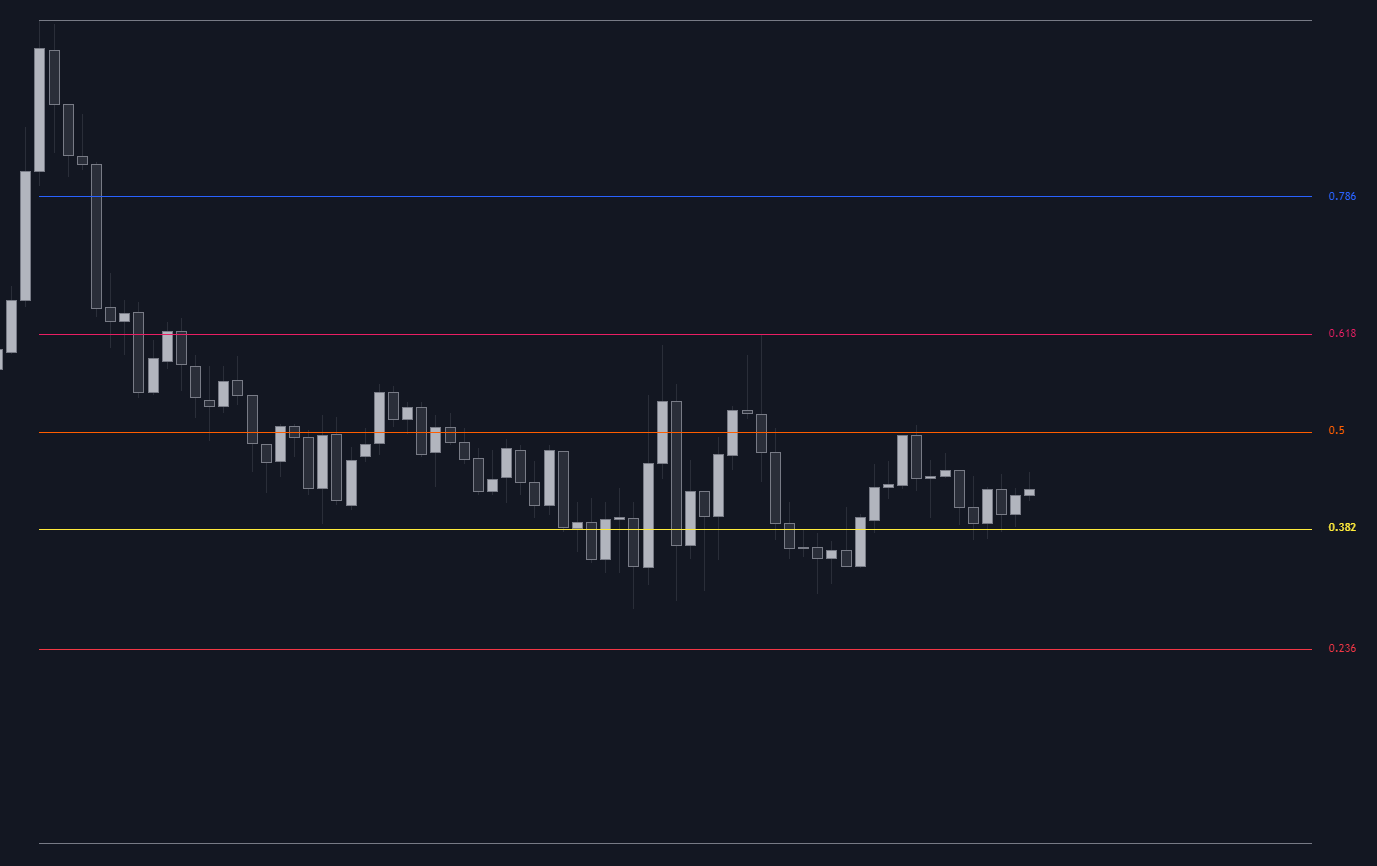Learn how Multi-Timeframe Analysis enhances trading decisions by aligning trends, improving risk management, and confirming signals across various timeframes.
Multi-Timeframe Analysis (MTA) helps traders make better decisions by studying price movements across multiple timeframes. It combines insights from long-term trends, medium-term corrections, and short-term fluctuations to create a more complete market view. Here's what you need to know:
- What It Does: Aligns trends, validates signals, and fine-tunes trade timing.
- How It Works: Use weekly charts for trends, daily charts for corrections, and hourly charts for precise entries/exits.
- Key Benefits:
- Better trade timing by syncing with multi-timeframe trends.
- Improved risk management with stop-loss and take-profit levels based on broader market data.
- Reduces false signals by confirming trends across timeframes.
Tools like LuxAlgo and TradingView simplify this process by offering indicators and features for seamless analysis. Whether you're spotting candlestick patterns or using Fibonacci retracements, MTA ensures a structured and informed trading strategy.
Advantages of Multi-Timeframe Analysis
Multi-Timeframe Analysis (MTA) isn't just a concept; it has practical benefits that can directly influence trading decisions.
Finding Better Entry and Exit Points
MTA allows traders to synchronize their trades with trends across different timeframes, leading to more precise entry and exit points. For example, you might notice a bullish trend on the weekly chart, spot a pullback on the daily chart, and then refine your entry on the 4-hour chart. This layered approach helps align long-term and short-term market movements [2][4].
Strengthening Risk Management
By offering a broader perspective on support and resistance levels, MTA plays a key role in managing risk. Traders can:
- Set stop-loss levels based on longer-term support zones, avoiding exits caused by normal market fluctuations.
- Adjust position sizes by factoring in volatility across timeframes.
- Identify realistic take-profit targets by analyzing resistance zones on multiple charts.
This methodical approach ensures that risk is managed with a well-rounded view of the market [4][3].
| Risk Management Factor | How MTA Helps | Result |
|---|---|---|
| Stop-Loss Placement | Use support levels from higher timeframes | Reduces chances of premature exits |
| Position Sizing | Account for volatility across timeframes | Balances risk according to market conditions |
| Take-Profit Targets | Analyze resistance on multiple charts | Sets achievable profit goals |
Confirming Trading Signals
MTA helps validate trading signals by comparing them across timeframes, which reduces the likelihood of acting on false signals. For instance, a buy signal confirmed on several timeframes using tools like RSI or MACD is more dependable and aligns with the overall trend [4][3]. This approach filters out market noise, keeping traders focused on informed decisions.
These benefits highlight how MTA can elevate your trading strategy by offering a structured and comprehensive view of the market.
Steps for Multi-Timeframe Analysis
Multi-timeframe analysis involves a structured approach to understand market trends across different timeframes. Here's how to put this trading method into action.
1: Identify the Long-Term Trend
Begin with weekly or monthly charts to determine the overall market direction. This "big picture" view sets the stage for your trading strategy and ensures you're not moving against major market forces [3].
Look for patterns like higher highs and lows to confirm the trend. Key support and resistance zones on monthly charts are crucial for spotting important price levels. Quarterly volume trends can also provide insight into the strength of the trend.
Once you have clarity on the long-term trend, you can shift focus to shorter timeframes for more precise trade planning.
2: Analyze Short- and Medium-Term Trends
After establishing the primary trend, move to daily and hourly charts. These timeframes help you pinpoint entry and exit points while staying consistent with the broader market direction [4].
- Daily charts reveal market structure, major price swings, and areas of support and resistance. They also highlight potential reversal patterns.
- Hourly charts fine-tune your timing, helping you make better decisions that align with the larger trend [1].
3: Cross-Check Signals Across Timeframes
Validate your trading signals by comparing them across multiple timeframes [4]. For instance, if a daily chart indicates a bullish breakout, check the weekly chart to ensure it aligns with the long-term trend. Indicators like RSI or MACD can be used on different timeframes to confirm consistency.
Key tips for signal validation:
- Align trends across at least three timeframes.
- Look for agreement between technical indicators.
- Monitor volume patterns over various periods.
- Consider tools like LuxAlgo for efficient multi-timeframe analysis.
Tools for Multi-Timeframe Analysis
Modern trading platforms come equipped with tools designed to simplify multi-timeframe analysis, helping traders make better decisions.
LuxAlgo: Trading Indicators and AI Tools

LuxAlgo offers tools like the Price Action Toolkit and AI Backtesting Assistant to make multi-timeframe analysis easier. These tools help traders spot patterns, confirm signals, and refine strategies. LuxAlgo integrates with TradingView, allowing smooth analysis across various timeframes. Its AI features also automate strategy testing, saving time and effort [4].
Here’s what LuxAlgo brings to the table:
- Identifies patterns across different timeframes
- Filters trade setups based on timeframe confirmations
- Automates strategy testing
- Works seamlessly with TradingView
While LuxAlgo focuses on AI-powered tools, platforms like TradingView provide foundational features that are equally important for multi-timeframe analysis.
Other Platforms for Multi-Timeframe Analysis
TradingView is known for its strong charting tools, such as multi-chart layouts and synchronized charts, which are perfect for analyzing multiple timeframes at once [2]. These features help traders monitor market movements across various time horizons without losing focus.
Key features of TradingView include:
- Multi-chart layout options
- Synchronized chart functionality
- Built-in technical indicators
- Customizable timeframe settings
Applying Multi-Timeframe Analysis
Now that you’re familiar with the tools for Multi-Timeframe Analysis (MTA), let’s dive into how to use this method with some key trading strategies.
Candlestick Patterns Across Timeframes
Analyzing candlestick patterns across multiple timeframes can improve trading accuracy. Start by checking higher timeframes to spot overall trends, then use lower timeframes to confirm specific signals [1]. For example, if you notice a bullish engulfing pattern on the weekly chart, verify it on the daily chart and fine-tune your entry points on the hourly chart. Adding volume analysis to this process can make your confirmations even stronger [2]. This structured approach not only improves signal accuracy but also helps with better risk management.
Fibonacci Levels with MTA
Fibonacci retracement levels become more impactful when used across various timeframes [2].
- Spot the Main Trend: Use weekly or monthly charts to determine the market’s overall direction [2].
- Apply Fibonacci Levels: Identify key support and resistance zones using Fibonacci retracements. When these levels align across different timeframes, they offer stronger validation [3].
- Cross-Check Fibonacci Levels: Test these levels on smaller timeframes. For instance, if the 0.618 retracement level acts as support on a weekly chart, verify it on daily and 4-hour charts for additional confirmation [2].
LuxAlgo's Price Action Concepts toolkit includes a customizable Fibonacci tool that can take retracement levels based on time periods, such as between previous quarter highs and lows, or even between technical levels of interest like market structure points and premium/discount zones.

By starting with weekly charts to define the trend, confirming patterns on daily charts, and refining entries on hourly charts, you can create a solid trading strategy. Tools like LuxAlgo’s AI can help validate both patterns and Fibonacci levels across timeframes, minimizing the chances of false signals [4].
Patience and discipline are essential for effective multi-timeframe analysis. Always verify signals across at least three timeframes before making any trading decisions [2][3].
Conclusion: The Role of Multi-Timeframe Analysis in Trading
Now that we've covered the basics and tools of multi-timeframe analysis (MTA), let's take a closer look at its role in trading. MTA helps traders make informed decisions by combining insights from various timeframes.
Here are three main advantages MTA brings to the table: it helps spot trends across different timeframes, strengthens risk management by refining stop-loss levels, and improves trade timing by syncing entries and exits with market movements [2][4]. Tools like LuxAlgo make this process easier with advanced indicators and AI-powered features that analyze trends and validate strategies across multiple timeframes.
To get the most out of MTA, traders should focus on:
- Trend Alignment: Make sure trading decisions follow trends seen across various timeframes.
- Signal Confirmation: Use higher timeframes to confirm signals identified on lower ones.
- Risk Management: Use longer timeframes to set well-calculated stop-loss levels.
When combined with other technical tools, MTA becomes even more effective. Pairing it with Elliott Wave Theory and Fibonacci retracements, for example, can help traders uncover more dependable opportunities [2]. This approach reduces the chances of false signals and improves the quality of trading decisions overall.
As markets continue to change, MTA remains a powerful tool. Including it in trading strategies gives traders a broader perspective, leading to better-informed outcomes [4][5].
FAQs
Here are answers to common questions to help traders effectively use multi-timeframe analysis.
How many time frames should I use?
Using three timeframes strikes a good balance for multi-timeframe analysis [5]. This keeps things straightforward while still giving you enough market data to make informed decisions. Using too many timeframes can lead to confusion and make decision-making harder. The goal is to keep it simple and focused while gathering the insights you need [1].
What is the multiple time frame analysis strategy?
Multiple timeframe analysis (MTFA) involves studying price movements across various time periods to align trends, confirm signals, and fine-tune trade timing. A three-timeframe approach helps achieve both clarity and precision [4].
Here’s how it works:
- Higher timeframes: Identify overall trend direction.
- Medium timeframes: Understand market structure.
- Lower timeframes: Pinpoint entry and exit points.
Tools like LuxAlgo can complement this strategy by offering advanced indicators for trend confirmation and optimizing trade entries [4].








